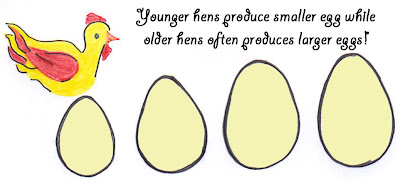
The comparison of protein concentration and prices among eggs.
The result shows that the white egg of duck has 12.27% more protein than white egg of grade B chicken egg. As for the chicken eggs, grade B egg has 13.13% higher concentration of protein compared to grade A egg and 33.15% higher than grade C egg.

When it comes to eggs, the most basic choice we have involves size and quality. Even though they are placed side by side on the carton, egg size and egg quality are not related. Nutrition facts associated with a medium-sized egg are not same as those for a large-sized egg. Instead, the grade an egg receives has to do with the egg's shell quality and how the egg stands once it's cracked. Shell color is determined by the breed of the hen; for chickens, it can range from bright white to brown. Shell color has no effect on quality, flavor or nutrition.
- Grade A: Eggs of the highest quality have shells that are clean, unbroken and are shaped like a typical egg. The egg white is clear, firm, and springy, while the egg yolk is well-centered, free from defects and has a slightly defined outline.
- Grade B: These lower grade eggs may have a shell that is clean or slightly stained. They will be clean, unbroken and normally-shaped. The egg white will be clear and reasonably firm, though it won't stand as high as Grade AA egg whites. The yolk will be fairly well centered, free from defects, and it will have a fairly well-defined outline.
- Grade C: Eggs will have clean to moderately stained shells. The shell will be unbroken, but may be weak or abnormally shaped. The egg white will be clear, though not springy, and the yolk may be slightly off center, enlarged and have minor (not serious) defects.

The albumin is the clear portion of the egg, accounts for most of an egg's liquid weight, about 67%, and is referred to as the egg white. It constitutes more than half the egg's total protein, niacin, riboflavin, chlorine, magnesium, potassium, sodium and sulfur. Albumin is more opalescent than truly white where the cloudy appearance comes from carbon dioxide. Carbon dioxide escapes as the egg ages, leaving the older egg more transparent than that of fresher eggs. Egg-white protein has a biological value of 100, the highest biological value of any single food protein. However, the size of eggs is influenced by a number of factors including climatic, nutritional and physiological.

(WORLD POULTRY - Elsevier Volume 18,No 6. '02. Problems encountered in Malaysian egg production and quality)
So, it is fair to say that worth paying RM0.30 for the amount of protein in grade B eggs contrast to the other grades of chicken eggs or the duck egg. In my point of view, we can’t conclude that grade B egg do has more protein level compared to other grades as eggs are nutrient-dense, calories, cholesterol, fat and protein values all vary depending on the egg size. Logically, of course the larger the eggs are, the more protein and other nutrients it contained. Apart from this, aging or staling of the white causes a breakdown in the protein, causing a watery white. Thus, the firmer or fresher the whites are, the more protein they have. However, if this experiment is about to be repeated, I would suggest various egg samples should be taken from different farms, age of hens and age of eggs since these factors influence the egg size and protein concentration.

©HAK CIPTA TERPELIHARA NURUL NABISAH BINTI HAJI MOHAMAD. ALL RIGHTS RESERVED 2009. Haha~
All in all, an adult need only about 62g per day. Egg alone is a complete protein with excellent quality; one egg will give about 6 g of protein. Other than eggs, sources of protein include rice, milk, meat, fish, whole grains and beans are all familiar to Malaysian diet. Since the percentage difference between grade A and B eggs are not significant, so it doesn’t matter whether one takes grade A or B egg in their diet. Quality and digestibility of protein are two major determinants whether the dietary protein intake can furnish an adequate level of essential amino acids to satisfy their functions in the body.


Well, as for me, I will rather choose grade A than grade B eggs because we’ll get more egg content as grade A is larger. Frankly speaking, I’m more concern on how much I can eat than how much protein I should take. For one-grade A egg-omelette, I can divide it to two separate meals – lunch and dinner. But if I use grade B egg, I still can eat for two meals but not with delight to fulfill my palate's desire. Sometimes, the quantity is more important than quality. Let’s consider the function off eggs in cake batter.
- Moistening: Due to large amount of moisture (water) present.
- Aerating: Due to the ability to form foam when whisked, which entangles large quantities of air.
- Enriching: Due to the presence of lecithin in the yolk.
- Structural: Due to the presence of protein in both the yolk and white that coagulate upon heating.
Since quantity is emphasized here, we must take into account about the duck eggs which have larger size. Despite of the costlier price, the duck egg white has very poor whipping properties compared to chicken egg white. The characteristics which were considered favorable to duck eggs were the greater stability to deterioration, the less pronounced chalazae, the reduced darkening around the yolks of boiled eggs, the reduced sulfur odor, and the lack of yellow color in the white (Metzer Farms).
Read more!







